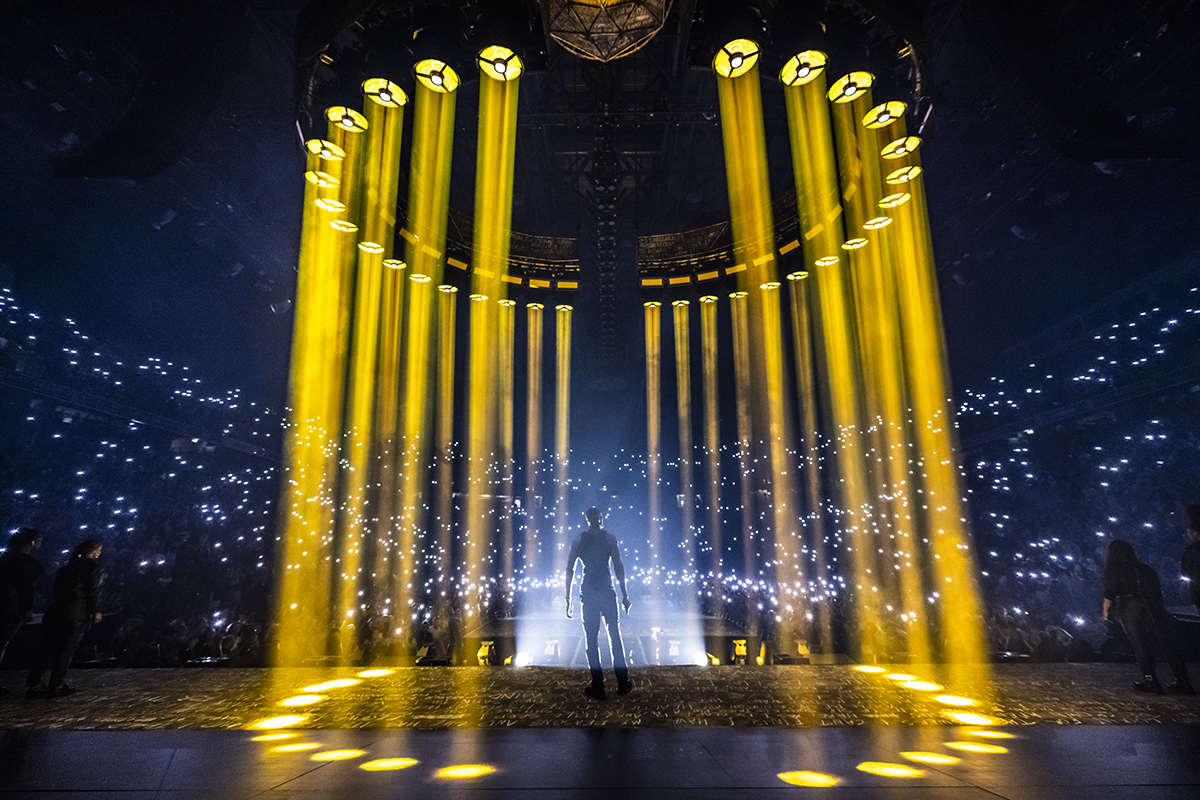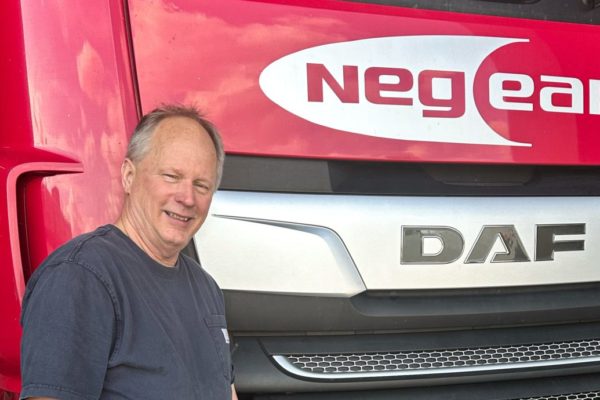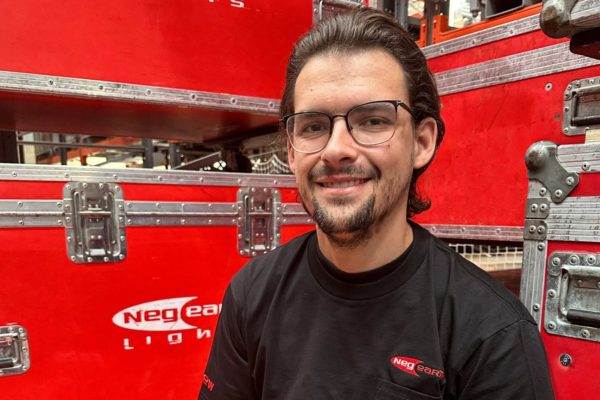HEAVY IS THE HEAD // STORMZY
The day before I visited Stormzy at Sheffield’s Utilita Arena, Micheál Martin, the Irish premier had cancelled his St Patrick’s Day meeting with US president Joe Biden in Washington after the Taoiseach tested positive for COVID. For us mere mortals, such decisions do not these days pertain – life seems almost back to normal. Tours, however, still need to exert presidential caution.
Joel Stanley, production manager for Stormzy, has a particularly good reason to remain cautious. Arguably one of the more extreme examples of the disruptions of this era – Stormzy’s tour has had to reschedule three times – the experience has crystalised the relationships with Stanley’s chosen vendors. “The biggest impact is how we respond to COVID now. My plan is defined by the concept that if we get an outbreak within our production, we can still have a show.”
That ability comes from strength in depth – in a nutshell, the tour is well-crewed with people at the top of their game. “I have a group of preferred vendors and specific people who I know can be relied on. Over the two years of COVID, I have always kept those companies and people informed at least six months in advance about what dates we were booking. The dates might get cancelled, as it transpired, but that meant the vendors could bank that time well in advance. In total, this is 42 days of work including band, build and production rehearsals, and the 15 shows.”
He continues: “That didn’t mean our needs were precise gear-wise. We didn’t have a lighting plot then, let alone a conceptual framework, but they all knew what the scale of the production would be and the length of the commitment. There is always a pressure to get fresh quotes from other vendors, but you have to weigh that against those magic ingredients, reliability – a mutual flow in that they can also rely on us – and consistency. I know our vendors will try their utmost to deliver. That’s something to be cherished. If I call Alex [Leinster, of Video Design] or Dan Bennet at SSE and say, ‘Look, we need to try something out’, they would bring the tools. There’s no nickel-and-dime attitude, no ‘we’ll come, but we’re going to have to charge you.’ They get on side, and if what we’ve proposed to trial doesn’t add up, they will proffer alternatives. You can’t put a price on that; they are all first-class on that score.”
Speaking of crewing and the pressures on touring during the pandemic, Stanley says: “Loss of crew from the industry has created a situation – the last thing we need is burnt-out people jumping from one tour to the next.
With COVID, we have had to be firm – from the very beginning, if someone tests positive, they are off; we get them taken care of and sent home, and they don’t return until they’ve had two consecutive negative tests.” Stanley himself fell ill just as rehearsals began. “That’s where the strength of the team shone through. “We’d already had the meetings and development sessions, it only remained to pull it all together, and they did that autonomously.”
The schedule for this tour is tight. “In effect, there are no days off on this tour,” says Stanley, “even though there are dark days between shows. Our crew protocol is to test every three days. Although I can’t mandate it, we ask that everyone wears a mask at all times indoors. Sadly, I don’t see that rigour applied with stage crews. At a time of continued uncertainty, it would be nice to know that was being done.” There is also an aspect of time. “We might have all had six months advance warning on the dates, but the uncertainty has meant we left hard details about design and concept to the very last minute. In effect, we had just six weeks from our first meeting to our first show, and the last three and half were all that anyone had to pull it all together.” No small feat considering this is a 19-truck production . . .
AUTOMATION
Stanley continues: “Ric Lipson led for Stufish; TAIT provided much from rental staging, plus some special items from the US. All those little bits of bespoke kit were managed by Holly Saul, Tamsin Webley and Jess Woodwood, three TAIT onsite production managers who took responsibility for different parts of the build whilst I was off sick. That worked because from our very first meeting at Stufish, everyone was present – Neg Earth, SSE, Video Design, Pyrojunkies/ER Productions, everyone. And of course, Bronski and Amber (Tawbox), who as creative directors oversaw the conceptual integrity and kept us on a coherent path.
Working for TAIT, Alex Burrows is responsible for all moving elements and their safety. “Kinesys chain hoists lift everything,” says Burrows, “and it’s all run off the Apex system. With the Vector control surface I operate, it’s all very precise and secure.”
There are three main elements, two involving artists. A crown of lights formed by two semi-circular trusses with scenic dressing hangs over centre-stage. The Crown variously descends, performs a penny roll, and eventually splits and re-orients almost completely vertically to form an ‘S’ for the song Superheroes. Within the Crown is a scenic dish as would be seen on pan scales – think scales of justice and you have the image. The other end is far downstage. The scenic balance beam between them is a separate truss. In motion, with Stormzy and/or DJ and totemic side-kick TiiNY in the pans, the visual impression is of a singular physical element as it seesaws between positions. Symbolic as well as dynamic, it’s a grand gesture and raises the audiences’ enjoyment another notch.
The third element is an elevator ‘flying carpet’ gag that opens the show, with Stormzy concealed behind the towering see-through LED wall. “It’s a powerful entrance at the top of the show,” says Burrows. “A hand-mounted bridge is temporarily positioned to give Stormzy access to mainstage when he dismounts. A 2m gap between the back wall of LED and mainstage conceals the Slab, a large scenic truss (72” SuperTruss) spanning the full 20m width of the stage. Dressed with LED video and with lights and pyro within, it’s raised by three hoists at each end and moves through a variety of positions horizontally and inclined. We feed precise Slab positional data to Luke Collins at the video servers, so image consistency is maintained between the Slab and the back wall of LED whatever its position.”
This was one of the most eye-catching elements of the show, but more of that later. “I have four watchers for close visual monitoring of all movements,” adds Burrows. “I’m positioned mid-stage right with a good eyeball on what is moving.”
VIDEO
Having a stage with such an open vista is a gift for the video element of the show. Across the back, the towering ROE Visual Vanish LED comes and goes like a chimaera. For those seated up off the floor of the arena, the panels of LED on the floor and across the steep ramp that edges the upstage boundary provide continuity of image when perhaps the seats are blind-sighted from what plays above. Then of course, there is the Slab.
All the equipment and crew is provided by Video Design. Luke Collins programmes and operates a pair of 4×4 disguise servers; Mark Davies cuts cameras operating a Carbonite 2ME switcher, and both men are employed directly by production, as so many of the principals are on this tour. Content is king on this show, as Collins explains: “For the most part, it’s produced by Tawbox, Bronski and Amber’s company. There are also some from Shop, another big content house. There are some really bold 3D animations.”
A good example comes early on during Cold, where the Slab tilts cross-stage and distinct avatars of Stormzy march up the incline. You may shrug your shoulders at that, but in the concert hall, it projected a quasi-augmented reality.
“As you know, we take the tracking data from Apex motion control, the accuracy of that system down to 0.1mm means the imagery never loses touch between the Slab and the back screen. Frequently, depending on the view angle relative to the stage, the Slab can be subsumed into the rear screen, even when moving between horizontal and tilted,” says Collins. It’s a striking illusion nicely exploited by the content providers and perfectly delivered by TAIT’s motion data and Collins’ precise programming. “The rear screen is suspended on a TAIT tab track so smooth that when it needs to part to expose Stormzy up on the ‘flying carpet’, it is opened manually. The screen position, when parted for that reveal, is not critical to images on any other screen in the set, and once shut, then point zero is restored.”
CAMERAS
Amongst other tours, Mark Davies has appeared on these pages as the man cutting cameras for ELO (see LSi September 2017). A different beast to Stormzy? “Actually, they are similar in an operational sense,” he opens. “I have three manned cameras in the pit, three PTZ robocams, a long lens at FOH, one track camera, and one handheld. All the operators come from the Video Design crew. The big difference is the significant isolation of Stormzy onstage relative to the rear LED screen, and to the exclusion of other musicians and performers. That does make it easier for me – even so, the key is the energy he brings to his performance.”
Discussing his work alongside content creator Bronski, Davies says: “The most important discussion we had was over camera positions. He understands cameras and knows about the drama that can be transmitted if you get the right angle. In that sense, we are definitely travelling in the same direction. Stormzy himself is equally knowledgeable – I noticed in rehearsals how he liked to play to a particular robocam, so we now put the handheld there to increase our ability to respond to him. He’s a very self-aware performer – a gift to any camera director.”
SPECIAL EFFECTS
The show is punctuated by a variety of effects supplied by Pyrojunkies and ER Productions but, as ever, it’s the application that matters. All are under the watchful eye of Liam Mace, who says: “I freelance though I have worked a great deal for Pyrojunkies in recent years. I had not worked for Stormzy before but have been pleased to find a degree of creative freedom in what we are doing. I was invited into the conceptual discussions from the beginning – important as in any performance there may be desired cue points but building a sequence that fits the role requires a proper understanding of the show designers’ intentions. To work well, pyro has to be sensitively applied.”
Then there is safety. “Where we fire from on the floor stage-right is quite restricted in terms of sightlines,” says Mace. “Besides direct line of sight for me, we have spotters at all critical points.” The firing system in use is from Galaxis Showtechnik. There is a lot of information available on this system, e.g. you can see interference from RF – an essential feature with everything triggered wirelessly. Galaxis runs to a firing script, linked to the show timecode.
FOH
Luigi Buccarello may count himself the luckiest man in audio to pick up this gig at short notice. “I met Kojo Samuel, the band’s music director, many years ago,” he opens. “I was mixing for Nao and he liked what he heard. Soon after, he invited me to mix for Rita Ora which I ended up doing for a number of years. It’s my good fortune that the Rita Ora production included Joel, our PM, as well as Kojo – Tawbox were also part of the team. When I was asked if I wanted to do this tour, I said ‘absolutely’. Who wouldn’t?”
Buccarello has an L-Acoustic K1/K2 system provided by SSE Audio with all the fidelity that system promises. “It’s a great rig, and I have a great tech in Richard Kemp. I’ve never worked with him before but he’s very flexible, has great knowledge of the system and got to know what I wanted very fast.”
For the opening, Stormzy’s arrival is preceded by a series of slowly-delivered low-frequency pulses of fierce energy. I’ve had my trousers flapped before and had some funny sensations in my abdomen, but I’ve never felt every hair on my head vibrate.
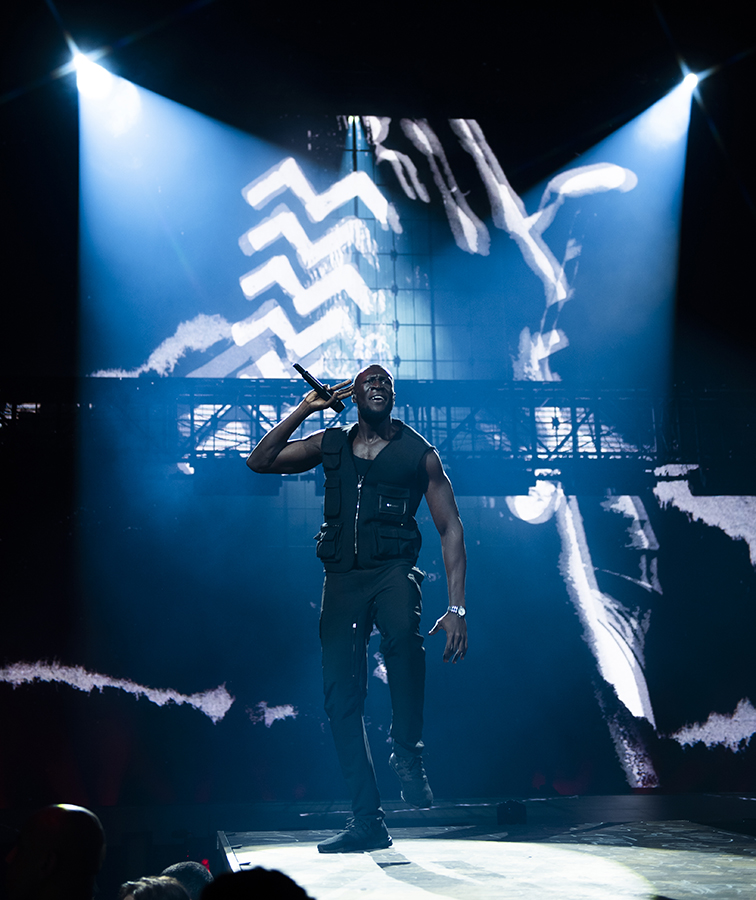
Of the show’s challenges, Buccarello says: “Stormzy is not one thing – he has multiple styles. The show starts with six songs, all hard grime, then suddenly we’re into gospel soul with a horn section. Those changes of style have to be made into something that is sonically-coherent; the performance has to hang together. The rule is to keep it simple – a couple of compressors and a de-esser are always there, but I have the threshold up so it’s not really engaged till I need it.”
Buccarello continues: “It’s a four-piece band, drums, bass, guitar, keys, DJ TiiNY, three brass players and six backing vocalists. I start by getting drum and bass where I like it, then my whole attention is focused on the vocals. Some numbers are very soulful so need to find a more organic sound. I build a template, soft and natural, then adapt song by song.” He mixes from an Avid Venue S6L. “I’m comfortable with this, it sounds amazing and I really like the workflow. I find it’s much like the Avid Venue Profile, just with smaller buttons and knobs, but it does so much more.”
MONITORS
Stage tech David Courtney and RF tech Patrick Taghavi ran me through the nuts and bolts of monitor world. “Raphael [Williams, Stormzy’s usual sound engineer] produces 21 mixes on his DiGiCo SD7 Quantum,” says Courtney. “The IEM system is Sennheiser EW G4 with the Digital 6000 series for the wireless mics; there are 12 handhelds. Every earbud is custom – Stormzy and the band all use Ultimate Ears, the rest have Cosmic Ears.”
Meanwhile, Taghavi is king of RF for SSE. “I do a lot of monitor work in France and RF is far less regulated there. Here it’s much more stable, not that it means I can be less vigilant. There are two separate RF antenna systems, one upstage of the LED back wall where the band and BVs mostly live and, one downstage. That makes things much more secure.”
Williams has been with Stormzy since 2017. “I did FOH initially, that’s the end of the snake I prefer, but what’s needed is some TLC from this end, so here I am. The first hurdle is the voice and the band being separate. Then there’s the room and the audience, which all have an effect. Stormzy has great projection, so do the BVs, but if you’re not careful, that BV detail can get lost.”
He continues: “With Stormzy, my process is to get it correct for me. He’s not looking to pitch from his IEM – he’s listening to the full show and needs to hear the band and the audience. That’s probably the key difference between what Luigi is doing out front and me – I bring balance to everything, just keeping the vocals present. He will bring more emphasis to the voices where needed.”
He concludes: “There’s not much treatment on the mixes for the performers in the desk – a bit of EQ, a bit of compression. I needed the SD7 for the output channel count. If I need extra, I need it immediately; the SD7 has that flexibility plus the Quantum gives me the Mustard Processing for a more powerful EQ. I use the UAD-2 racks post desk to finesse what goes to each of them.”
LIGHTING
Much of the illusory nature of the show described in the video section above would lose credibility were it not properly lit. Lighting designer Tim Routledge presents a palette that often results in something of a ghostly, otherworldly character – ‘dirty’ is the adjective he uses, but make no mistake – this is no easy show for lighting, with Stormzy spending so much of the night alone on a giant stage bereft of any structural bling.
With most of the core performance area so far downstage, you might imagine a show played in-the-round. There, you have the nub of the dilemma for Routledge and his key programmer, James Scott. The show is cue-heavy and has taken a great deal of thought in a remarkably short period of time, but neither man seemed too flustered.
“The Crown at the centre of the rig is populated with the new SGM G-7 BeaSt,” says Scott. “A beam light much like the Vari-Lite VL6000 used elsewhere in the rig, it has a tight pencil beam and comparable effects. To me the BeaSt is not noticeably brighter, but at the centre of that Mercedes-like symbol across the lamp sits a very bright, LED strobe.” Routledge adds: “The BeaSts in the Crown are a bit more special. That centre strobe element can be bled in gently, an effect we use to give the Crown a jewel-like feel.”
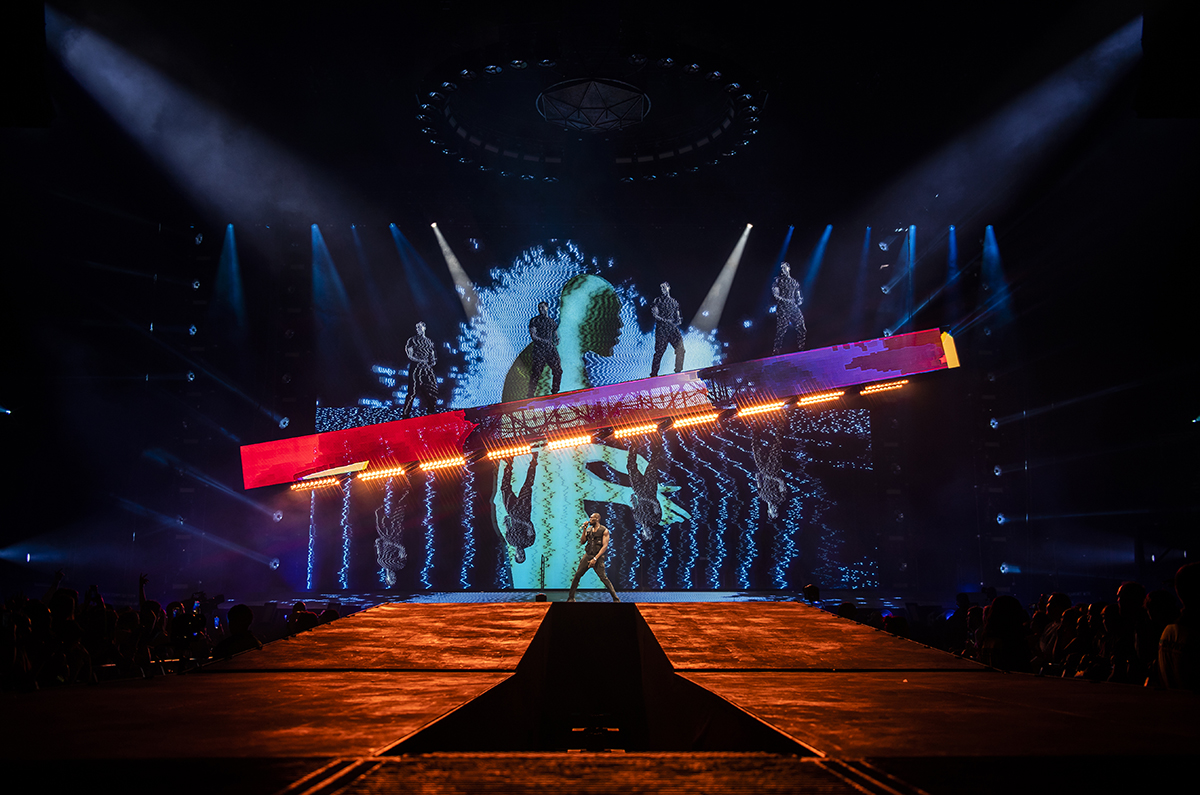
“You’ll also see what looks at first like the classic X4 Bar,” continues Scott, “but is the new FR10 from GLP. The LEDs have a bigger aperture lens and you have individual zooming per lens. There are 28 of them on the Slab.” This individual zooming stood out on One Second. A ripple runs across the bottom edge of the big screen; zooming in and out on it as it ran across the FR10s made it appear more fluid. In Routledge’s own words, “the new GLP FR10s are stupendous.” Elsewhere in the rig, the SGM Q-8 came in for praise. “The segmented pixel plate and the four lines of strobe pixels around that rectangle are so bright and so versatile.”
Keylight is provided by eight Robe Forte lights. “Previously, we used the Robe BMFLs, a good lamp for the job, but the power and CRI make these new ones just perfect.”
Scott runs the show from a grandMA2 desk. “I’m using Cue Points, the new software that allows you to timestamp – that gives us separate markers for pyro, lighting, everything running from the same hymn sheet.”
Speaking at length to Routledge several days after the show, he outlined its structure. “It falls into three distinct sections – a heavy grime Stormzy; a tender, soulful Stormzy; and a playful Stormzy, which is where he has fun and things go a little crazy. Despite the large stage and the deep double thrust, we were really careful about which part of the stage he uses and when. He’s not just running about all over the place. Each section of the audience gets their turn, and he is really good at hitting his marks.”
Routledge continues: “Getting any reveal opening is so hard these days – an audience of 10,000 with their phone-lights on can catch anything concealed behind a blow-through LED screen. That’s why we went for the blinding strobe punch for the opening, to assault the retina. This heavy grime section is all lit through smoke. Much of the lighting is concealed within the stage, so the lighting comes mainly from below. The stage has several moats so there are plenty of places for lights to shine through. We use up to eight Robe Fortes spots to track him, though not all of them all the time. We colour him a lot at the beginning and with a lot of ‘dirty’ colours. Because of his tall stature, it’s like lighting an animated stature – we can use monochrome from the rig and make him pop out in a dirty red, for example. James did some great programming for me there.”
Speaking of the scenic details, the LD says: “The Slab truss is Ric Lipson’s idea – rising from below is unexpected. Audiences are all too familiar with scenic elements that lower in from concealment above. For the top of the show, the Slab is hidden just downstage of the rear screen.”
“For the soulful Stormzy part of the show, we reveal the band. But the focus remains on him, with the descent of the Crown for Heavy is the Head; down low enough to be figuratively oppressive above him as he talks though the pressures, he feels from his meteoric ascent to stardom. We took a deliberate tack not to make the Crown some clear symbolic thing; its scenic dressing purposely dishevelled. Then it’s made fun of with a penny roll, and of course, by how it’s lit. By the time we reach Superheroes it’s no longer a crown, but split and raised vertically to form an ‘S’.” It’s worth noting that the show is by now nine songs in, yet it’s not till song fourteen, Cigs & Cush, that Routledge reveals a wall of MAC Auras concealed behind the Vanish screen, and the Q8 strobes.
Routledge continues: “The VT Don’t Forget To Breathe is our curtain-raiser for the havoc section. Wiley Flow follows, a real mosh-pit favourite from his early days. The Scales of Balance descend at speed and we have the artist raised above his audience. The Scales are symbolic of justice, the speed they move at is dramatic. James and I were discussing all the possibilities of what to wrap the beam of the Scales with and he came up with Portman P2 tungsten as they have the ability to bend in two planes. To enhance that view, we avoided using followspots on the Scales as the audience to the opposing side would have been dazzled. Instead, we used Astera Pixel Bricks within the scale pans.
“By the time Shut Up begins we’re all in full-on fun mode. Stormzy loves comedy sunglasses and has a pair of heart-shaped ones presented to him for the song – this man does not take himself too seriously! The Free VT and song section gently reveals he’s about to release a new album and then we’re straight into Blinded By Your Grace, a great sing-along number. Finally, the show plays out to his comedy lampoon of Boris Johnson in Vossi Bop.”
In conclusion, I can only agree with Routledge, who observes: “There is so much powerful variety of style in presentation and content. Stormzy is a remarkable performer.”
Originally Published by LSi Online.
Photo Credit: ‘Timmsy’ Andrew Timms
Do you need lighting and rigging equipment for an upcoming production?


